
http://threesology.org
Note: the contents of this page as well as those which precede and follow, must be read as a continuation and/or overlap in order that the continuity about a relationship to/with the typical dichotomous assignment of Artificial Intelligence (such as the usage of zeros and ones used in computer programming) as well as the dichotomous arrangement of the idea that one could possibly talk seriously about peace from a different perspective... will not be lost (such as war being frequently used to describe an absence of peace and vice-versa). However, if your mind is prone to being distracted by timed or untimed commercialization (such as that seen in various types of American-based television, radio, news media and magazine publishing... not to mention the average classroom which carries over into the everyday workplace), you may be unable to sustain prolonged exposures to divergent ideas about a singular topic without becoming confused, unless the information is provided in a very simplistic manner.
Whereas human thinking transitions between the digital and analogical can be noted, the transitional parsings are subjected to limitations of quantity, analogy and environmental influences. By subjecting the binary digital formula to an exercise of traditional logic... that we may metaphorically reference as moves in the diagonal- horizontal- and vertical realms like a game of chess or checkers having additional boards (platforms) and playing pieces combined there-to; the usage of a binary footing falls over unless we subject it to some three-part process of equilibrium like a two-legged person being equipped with three semi-circular canals in the ear. However, we must also note that this system of equilibrium is situated in the ear instead of in the center of the body as might a gyroscope be placed. In other words, if we view a persons two-legs as a binary system, and we are trying to construct a humanoid type of artificial intelligence... the brain and mechanism is in the opposite corridor from the legs. The binary is fitted with a singular torso that is fitted with a binary set of appendages (arms), followed by a singular compartmentalization of primary sensory organs (eyes, tongue, ears) couped to a central processing unit... though as yet unidentified auxiliary processing units (such as rudimentary memory) may exist in other body parts.

But, the two legs may not be a fundamental binary unit, since we have established a triplet code existing with a basic genetic unit called DNA. In other words, the human body may not be utilizing an underlying binary formula because there is no functional on/off electrical switching taking place. Representing the binary situation of life/death as an electrical switch is a false analogy because a "switch" implies multiple uses... which is not characteristic of life. Nor does the concept of an after-life supply us with much confidence that this presumed switch is three-patterned based. Just because we can see instances of two-patterned structures occurring with the human body does not mean there is an underlying dominant binary system that is operational. Appendages such as the two arms, two legs, two eyes and two ears are not necessary for the brain, as a central processing unit, to continue functioning. The story of Helen Keller provides us with an example of someone achieving a high functionality without being able to see or hear. In fact, though it is not publicly acknowledged as a reality, there is the consideration that a person whose head was deprived of a body but attached with a means to nourish it, might live a long time if its concepts of self-perception were devised to fit its circumstances... and not rely on its ideas of normalcy based on a mobile physical relationship with the world.
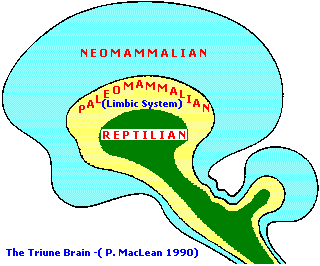
In the case of this bodyless wonder (with an electronic voice?), do we then conclude that a binary formula does exist because of two brain hemispheres, though some would argue that our brain is of a Paul Maclean triune structure? Or do we resort to inferring there exists an underlying binary-based molecular structure which provides a two-based architecture? If there is no two-based electrical firing amongst neurons and no influential two-patterned overt structural influence, what then influences various concepts of duality to emerge? Are such expressions a natural developmentally progressive expose' of sequential brain development learning how to think digitally, by formulating ideas with simple 1, 2, 3 (single, dual, triple) numerical references by way of primitive analogies? While an analog conceptualization precedes a digital one, this does not mean the adopted digital representation of an analogy is a "true" digital expression. It merely represents the mind of humans transitioning into a digital framework of perception. Such a process uses whatever concepts are most readily available to represent as a "digitation", particularly if the presence of an actual digital formula is overlooked, not realized, or obscured because it has been rendered into an object of analogy by being clothed in the garments of an acceptable model of understanding, in accordance with the level of conceptual primivity viewed as a standard or higher order of thinking.
One might want to consider that by increasing physiological complexities, there is a resultant increase in conceptual complexities to be interpreted as increased intelligence. However, the so called conceptual complexities of humans appear as perceptions with simple enumeration that are compounded... and it is this overlay that is then labeled as increased intelligence by way of accumulation. As if the emergence of so-called intelligence is due to the presence of numerous cells and interactivity... from a single celled organism to a multi-celled organism such as humans. This is not to say the single celled organism does not exhibit a level of intelligence commensurate with its design functionality, we so-called smart humans just aren't smart enough to measure the single cell's level and type of intelligence. By labeling "sentient being" in terms of human behavior, this standard is imposed on all life forms... just as those in AI research who utilize a binary standard, are imposing this structural formula as THE sole means of defining a key component of artificial-based intelligence.
Human physiology and behavior is being used as the standard by which we have traditionally defined consciousness and intelligence, though animals exhibiting similarities are described as analogous (analog), but lesser forms thereof. Some venture to use the lack of our understanding all physical and mental conditions as a representation that such processes were designed by a being with a higher intelligence. Whereas unexplained events have commonly been attributed to good, bad, or indifferent spirits or ghosts, many instead choose to use the word "god" as an explanation. Those who try to figure out that which is not understood, are sometimes referred to as trying to play god... a statement used to disparage a person into relinquishing their attempts and thus keep the world in a state of ignorance that is amenable to those who cherish a conceptual framework within which a god retains supremacy. Their perceptions are relegated towards the development of an understanding consistent with their preferred inclination... just like those who have developed a consciousness in accord with a binary perspective around which their sociability rests. It has become a god of reference though they are not aware of such, and may even deny... though their activities clearly suggest otherwise.
If an alternative to binary thinking is not suggested, though in so doing we bring to bear the realization that current computer design is a perception having developed into a culture; how do we get the inhabitants of this culture to look elsewhere for conceptual sustenance, if their culture is prosperous and provides many social amenities? How do we get them to fully realize that a true digital framework does not revolve around the current binary perspective, when their current sphere of culture revolves around it and placates their energies and resources to it like offerings to a god? How does one get a software engineer to alter their path they've been on for thirty years upon which they have carved out a socially recognized niche' that others may be envious of, and thus promotes their personal standing in a billion dollar corporation? How can one put up a detour sign in the path of someone who is committed to a trek, called a game, for which they have a large knowledge about the rules being played... but will be a beginner, if not a dunce, in a different game? And, if you are a company such as microsoft giving away newer versions of a former binary platform that is the dominant structure in use, shouldn't companies and individuals be wary that they may be walking into a trap that ensnares the public into surrendering itself to a forthcoming ordeal of future subjugation? In other words, people have a right to be suspicious.

The topic of a trinary orientation from which a different type of computer platform can be derived, is particularly unfamiliar to most people. Even greater suspicion may arise in those who are not readily enabled to develop analogical points of reference with which to apply to their pursuits of enhanced well-being. And if in trying to apply past binary points of reference they are confronted with recurring stumbling blocks or dead ends, how are they to be assured of usefulness in their present circumstances. No less, if there are no quick returns for investing time resources and energies, or distant larger returns expected within the scope of patience to be assigned their given benefit of a doubt; of what type of reward must be offered if even the reward(s) is part of the discovery... like an adventure into uncharted territory? The promise of developing a human-like artificial intelligence may not be enough reward for all those being asked to support such an expedition to this new world.
Needless to say, there is no guarantee that we will find anything of commercial value during our first efforts. No less, what is the direction to take if there is no commercial interest directing the implementation of a map, even if it is first drawn up by speculators? And what if that being spoken of to be sought is not that which we can presently see nor fully articulate... leaving description to be muddled by present commercial interests to make a fast buck, or otherwise leave funding to a government source that will mangle the freedom of exploration or expect some unrealistic concession as a tribute defining which relinquishes ownership to those whose only interest is in hoarding and not sharing? How does one describe the riches of a new world that may be unlike that which is defined in terms of present and past rewards to be garnered from similar exercises of exploration? What if a trinary platform of conceptualization produces a computational design our minds are not conceptually prepared for and must accommodate quickly to, because once its ON switch is activated, it can not be shut down without a large scale disruption of the economy and social governance? Analogously, what if when it is exploded onto the social scene, everyone's mind is ignited into a fervent blaze; as was the consideration at Los Alamos upon the detonation of the first atomic bomb?

And let us ask if the atomic bomb relied on an analog or digital program, or something else? Did the actions of the bomb constitute a digital program taking place on the atomic level? If we assume that a digital program is inferior to a digital one, in terms of human application to an on/off binary mentality, is there something superior to the digital but this requires a trinary mentality in order to make use thereof? Then again, as noted earlier, the binary system as a digital representation, is merely the masquerading of an underlying analog situation. If we look about nature for an natural expression of a digital program, we are confronted with a mentality that typically resorts to the usage of an analog (analogy, analogous, comparison) system. The usage of a digital conceptualization is little more than an elaboration of an analog system... like numbers being viewed as letters or some other symbol, that is reverted to an abbreviated system of numbers that can be compared to the duality of an on/off electrical switching environment.
While we are thinking about Artificial Intelligence beyond the environment of mere robotic systems, such as in the science fiction case of a cybernetic organism, we must wonder whether the basic bio-molecular entities known as DNA, RNA, and Proteins run on an analog or digital program? Indeed, do life forms exhibit an analogic, digital or some other type of programmatic formula? And even though we may define the polarization of molecular activity in which left/right handedness (is described in terms of mirror-imaging) as a binary representation, let us look a little closer from a description offered in the Britannica:
Studies by the German chemist Emil Fischer in the late 19th century showed that carbohydrates, such as fructose and glucose, with the same molecular formulas but with different structural arrangements and properties (i.e., isomers) can be formed by relatively simple variations of their spatial, or geometric, arrangements. This type of isomerism, which is called stereoisomerism, exists in all biological systems. Among carbohydrates, the simplest example is provided by the three-carbon aldose sugar glyceraldehyde. There is no way by which the structures of the two isomers of glyceraldehyde (see the formulas below, which are the so-called Fischer projection formulas that are commonly used to distinguish between such isomers) can be made identical, excluding breaking and reforming the linkages, or bonds, of the hydrogen (-H) and hydroxyl (-OH) groups attached to the carbon at position 2. The isomers are, in fact, mirror images akin to right and left hands; the term enantiomorphism is frequently employed for such isomerism. The chemical and physical properties of enantiomers are identical except for the property of optical rotation. As explained above, optical rotation is the rotation of the plane of polarized light. Polarized light is light that has been separated into two beams that vibrate at right angles to each other; solutions of substances that rotate the plane of polarization are said to be optically active, and the degree of rotation is called the optical rotation of the solution. In the case of the isomers of glyceraldehyde, the magnitudes of the optical rotation are the same, but the direction in which the light is rotated—generally designated as plus, or d for dextrorotatory (to the right), or as minus, or l for levorotatory (to the left)—is opposite; i.e., a solution of D-(d)-glyceraldehyde causes the plane of polarized light to rotate to the right, and a solution of L-(l)-glyceraldehyde rotates the plane of polarized light to the left. Fischer projection formulas for the two isomers of glyceraldehyde are given below (see below Configuration for explanation of D and L). 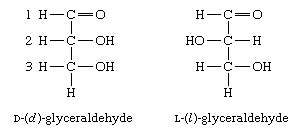 Source: "Carbohydrate." Encyclopædia Britannica Ultimate Reference Suite, 2013. |
The above illustration describes a primitive type of trinary computation. In other words, the dynamics being described are basic switching mechanisms using light that is configured by the behavior of atoms which can be translated into electrical impulses. There is a center position with two sides. Present binary computation does not employ a common center around which a binary event exists, though attempts to do this are initiated by the use of a Boolean type of logic. By using an alternating type of centrality, we will be enabled to alter the types of portrayed binary formulas consistent with human thought... particularly creative, innovative and genius level "computations" upon which such idea as "serendipity", "accidental" or even "mistake" are used to account for what others might describe as an anomaly or mutation in thought processing. The development of what might be illustrated as "optical electronics" (an amalgamation on the atomic level of optics and electronics to produce a third entity...) will be the "child" of a trinary form of computation... though it will be one of several that can be developed with different "personalities" of computational behavior.
A short comment about light may be used as refresher for some, and an introduction for others:
(Light is) electromagnetic radiation that can be detected by the human eye. Electromagnetic radiation occurs over an extremely wide range of wavelengths, from gamma rays, with wavelengths less than about 1 × 10-11 metre, to radio waves measured in metres. Within that broad spectrum the wavelengths visible to humans occupy a very narrow band, from about 700 nanometres (nm; billionths of a metre) for red light down to about 400 nm for violet light. The spectral regions adjacent to the visible band are often referred to as light also, infrared at the one end and ultraviolet at the other. The speed of light in a vacuum is a fundamental physical constant, the currently accepted value of which is exactly 299,792,458 metres per second, or about 186,282 miles per second. Source: "Light." Encyclopædia Britannica Ultimate Reference Suite, 2013. |
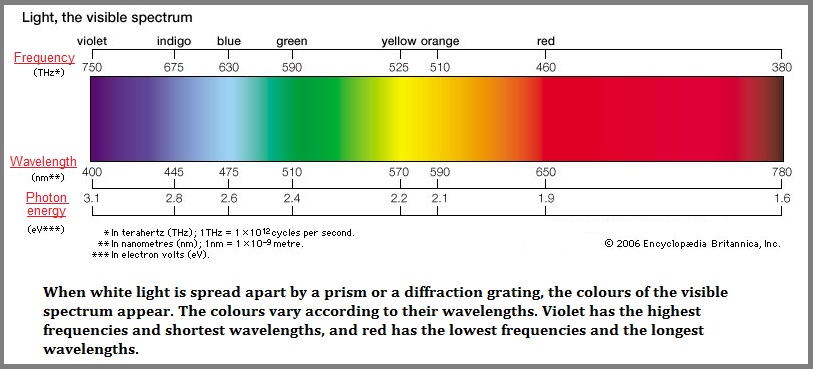
When a molecule changes its electronic state without direct absorption of light, as in nonradiative decay or internal conversion, it may go into a new excited state, which, left alone, would be short-lived (less than about 10-6 second); or it may go into a long-lived (metastable) excited state. Both types of reaction are known in photo-chemistry, but the long-lived states are particularly important in storing energy for chemical processes. The most important of the last named kind of transition is a Singlet >>> Triplet transition. Singlets and Triplets are electronic states that differ in having paired and unpaired electrons, respectively. Triplets are the most commonly found phosphorescing states. They cannot radiate rapidly and are therefore among the most long-lived excited species. For this reason triplets are frequently the primary products of photo-chemical reactions. Excited singlets are sometimes found, but they more often decay,...to triplets. Triplets can be identified by their magnetic properties; by contrast with singlets, the individual electron magnets of a triplet do not cancel each other so that triplets exhibit weak magnetism (paramagneticism), which can be detected by suitable techniques. |
The word "paired" in the above reference may be interpreted as binary. The "unpaired" reference can be interpreted to represent an instance of trinary, though any odd-numbered quantity might be seen as exhibiting a paired state in terms of some exhibited equality such as distance, conformation of appearance, etc...

Handedness, or chirality, is an important issue to take into consideration with respect to a binary or trinary computational formula using a molecular form of optics applied to electronic switching. Like the right and left hands being mirror images of one another, they are not images of themselves. While an ON and OFF switch represents polarization, the "ON" does not actually represent the "ON" as a separate distinction. Nor can an "OFF" represent itself. A distinction requires the presence of both being viewed from yet another perspective. A means of contrasting the polarized positions is required. A binary formula is not able to distinguish the contrasts of "off and on" because its "self identity" is either off or on. It does not provide a centrality or other variable position in order that a distinction can be assured. A binary system presents us with the case of a mirror image illusion. Previous examples of illusions provided us with representative binary models of perception involving single images... like different people looking at the same ink blot and providing different interpretations of what exists. A binary computational formula provides us with the illusion of intelligence. With respect to handedness, let me provide a different perspective of this idea from a Britannica article on isomerism:
Enantiomers ...In the introduction of this article, it is stated that one's hands are related but not the same. Exactly how are they related? Each has a thumb, little finger, and so on. Yet the hands truly are not the same, for they are not super-imposable. In effect, the left and right hand are mirror images; the left hand is super-imposable on the mirror image of the right hand but not on the right hand itself. Some molecules are related to their mirror images in the same manner. Such molecules are, by definition, stereoisomers, and they go by the special name of enantiomers. The phenomenon of handedness, or “chirality,” is perhaps the most important phenomenon related to isomerism. Many objects in the macroscopic world are chiral. A scissors and a screw are familiar chiral objects; they are not super-imposable on their mirror images. But related objects, a simple knife or a nail, for example, are super-imposable on their mirror images and thus are not chiral. The simple test for chirality is the same for objects as it is for molecules: Is the object (or molecule) super-imposable on its mirror image? If it is not, it is chiral. If it is, the object is achiral (not chiral). 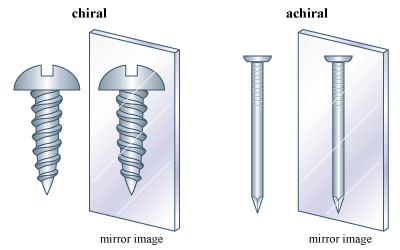 If each hydrogen atom in a molecule of methane were replaced with a different atom, one possible result would be bromochlorofluoroiodomethane (CBrClFI). The mirror images of this molecule are not super-imposable. There are definitely two enantiomers of this molecule. 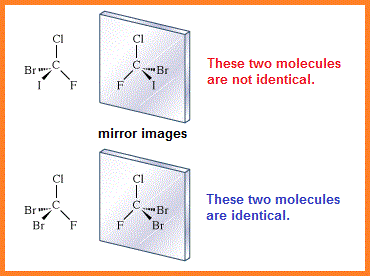 The molecule, with four different atoms (fluorine, chlorine, bromine, and iodine) attached to what is called a stereogenic carbon, is identified as chiral. Several questions and problems now appear. How are the two enantiomers different physically and chemically? On a more mundane level, how can one specify in words one of the two enantiomers? How is one to differentiate the right-handed molecule of bromochlorofluoroiodomethane from the left-handed version, for example? A rather complex protocol has been devised, and it is worth giving a simplified version of it here. In the so-called Cahn-Ingold-Prelog (CIP) protocol (named after British chemists Robert Cahn and Sir Christopher Ingold and Swiss chemist Vladimir Prelog), one first assigns priorities to the four atoms attached to the stereogenic atom, in this case the carbon at the centre of the tetrahedron. The atom of lowest atomic number is given the lowest priority, 4. In this case that atom is the fluorine (atomic number 9). The atom with the highest atomic number, iodine (atomic number 53), gets the highest priority, 1. Chlorine (atomic number 17) is priority 3, and bromine (atomic number 35) is 2. In the second step of the protocol, one sights down the bond from carbon to the lowest priority (4). Finally, one connects atoms 1 to 2 to 3 with an arrow. If that arrow is clockwise, the molecule is called an R enantiomer. If the arrow is counterclockwise, the molecule is called an S enantiomer. (R comes from rectus, the Latin word for “right,” and S comes from sinister, the Latin word for “left.”) The CIP protocol is simple in the example chosen, but very often more-detailed rules must be applied to assign R and S. ...In summary, a molecule with one stereogenic carbon can be either R or S—in a sense, “left-handed” or “right-handed.” One set of such molecules is of profound biological importance: the L-amino acids. The business of the body—biological function—is controlled by proteins, which are polymers of only 20 possible amino acids. All the amino acids but the achiral glycine contain a single stereogenic carbon, and all of them but glycine are left-handed. It is not clear why this sense was selected through evolution; perhaps that selection followed from an initial accident selecting for left-handed amino acids. Extraterrestrial life (should there be any) may well be either left- or right-handed. All physical attributes of enantiomers are identical except for one rather arcane property: the direction of rotation of the plane of plane-polarized light. If one enantiomer rotates the plane in one direction (say, clockwise) as one views the beam, the other enantiomer will rotate the plane by the same amount in the other direction (in this case, counterclockwise). For example, the rotations of standard solutions of (R)- and (S)-2-aminobutane are -7.4 and +7.4 degrees, respectively. The chemical properties of enantiomers are also identical, as long as the other reacting molecule is achiral. Chemical reactions of enantiomers are analogous to a hand grasping a ball. If the ball is featureless, one's right and left hands (enantiomers) have exactly the same interactions with the ball. However, if the ball has the word “Label” written on it and is thus a chiral object, that labeled ball will be optically active; it will mimic a single enantiomer. The left and right hands will interact differently with the labeled ball. The little finger of the right hand will approach the capital “L” of “Label” while the thumb will approach the lowercase “l.” For the left hand, the interactions will be just the opposite: the little finger will approach the lowercase “l” and the thumb the capital “L.” 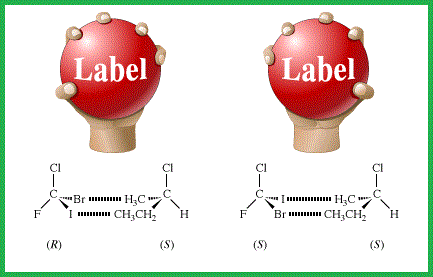 |
Subject page first Originated (saved into a folder): Thursday, November 13, 2014... 5:50 AM
Page re-Originated: Sunday, 24-Jan-2016... 08:51 AM
Initial Posting: Saturday, 13-Feb-2016... 10:59 AM
Updated Posting: Sunday, 23-June-2019... 2:45 PM
Herb O. Buckland
herbobuckland@hotmail.com